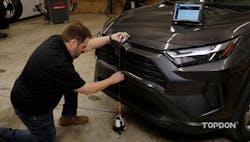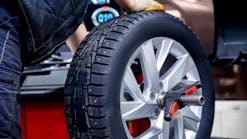Advanced driver assistance systems (ADAS) have come a long way in a short period of time. Once found only on high-end luxury makes, features like lane departure warning, adaptive cruise control, blind spot monitoring, and rain sensors can now be found on many new cars at every price point.
For the service industry, ADAS requires another layer of technical expertise, as ADAS must be calibrated and tested following collision repair, custom modifications, and the usual replacement of faulty components. Shops need to invest in the special equipment required for static and dynamic calibrations and in training technicians on the proper procedures.
ADAS service is a fast-developing sector, and as such, questions pop up daily and misconceptions spread quickly. Step one in avoiding pitfalls is to follow manufacturers’ specs. It’s important to defer to factory service information and check the OEM’s position statements because they change.
Step two is having a clear view of what has been done to the vehicle. What ADAS boils down to in terms of whether it’s going to be a cut-and-dry repair or a nightmare, is how many different fingers have been in the pot and what has been touched on the vehicle. Those are really the big factors that are going to determine, ‘Is this going to be easy, or is it going to be a challenge?’
From that baseline, determining the best course involves sidestepping some common misconceptions.
Misconception: Dynamic calibrations are always easy
A lot of people think the driving calibrations are ‘easier’ than the static, which uses the targets. There are more and more situations where that is not necessarily true. That can cause shops to price the dynamics too low when they get into the ADAS game. They may think, ‘Hey, I only have to drive it for 15 or 20 minutes so it’s no big deal, I can charge less for that.’ In some situations, it may be very easy and straightforward. But there are certain vehicles where that is not the case. Some European vehicles, in particular, can take an hour or more of driving to finish the dynamic.
Additionally, there are still the same potential pitfalls with dynamic as there are with static. You can still have bright sunlight shining into the forward-facing camera and that can cause calibration problems, just like if you were doing a static calibration with a forward-facing camera.
Misconception: Aftermarket parts are always acceptable
Although this is a rapidly evolving situation, when it comes to the replacement of anything that’s going to directly interact with a sensor, OEM parts are usually the safer bet.
The best example is a windshield. When you think about what a camera physically is, it’s basically taking light and turning it into information. When you stick it behind a windshield, the light refraction of the windshield glass is going to change depending on who made the windshield. The manufacturer knows exactly how to make that windshield through their dedicated supplier. The aftermarket companies may not make it the right thickness. It may not have the correct light refraction. That’s going to lead to calibration problems.
Parts need precisely matching characteristics for ADAS sensors to function properly, but the aftermarket has not yet figured out some of these challenges in regard to replacement parts.
Misconception: Training employees to use ADAS equipment is too much trouble
The reality is, that existing training programs can get a crew up to speed in a remarkably short time. If you take a class like the 4-hour class that TOPDON offers that teaches you to think about it in terms of three-dimensional geometry and physics, it’s very easy. Because the root cause of the problem is always in one of those areas. Is there any factor that is changing the 3-dimensional geometry of the vehicle? If it has more weight in it, is that going to affect the 3-dimensional geometry? Yes, because it’s going to tilt it. Is the sensor cocked in the bracket? That’s going to affect the 3-dimensional geometry.
When working through ADAS issues, heading off potential problems begins with communication. It’s really about asking the right questions and setting the expectation level with the customer. As ADAS equipment becomes the universal norm for all new cars, being able to service the array of sensors and cameras will be a critical part of a technician’s role. And that’s no misconception.
Visit TOPDON's website to read about more common misconceptions about ADAS equipment.



